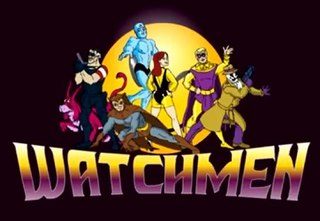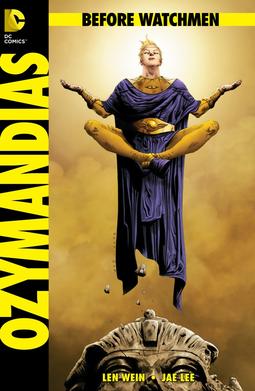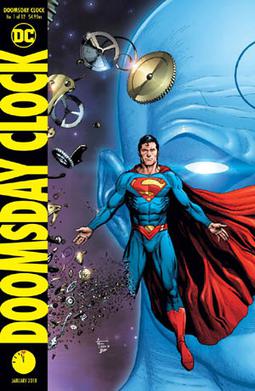
Watchmen is a comic book limited series by the British creative team of writer Alan Moore, artist Dave Gibbons and colorist John Higgins. It was published monthly by DC Comics in 1986 and 1987 before being collected in a single-volume edition in 1987. Watchmen originated from a story proposal Moore submitted to DC featuring superhero characters that the company had acquired from Charlton Comics. As Moore's proposed story would have left many of the characters unusable for future stories, managing editor Dick Giordano convinced Moore to create original characters instead.
Rorschach is a fictional antihero in the graphic novel limited series Watchmen, published by DC Comics in 1986. Rorschach was created by writer Alan Moore with artist Dave Gibbons; as with most of the main characters in the series, he was an analogue for a Charlton Comics character, in this case Steve Ditko's the Question. Moore also modeled Rorschach on Mr. A, another Steve Ditko creation on whom the Question was originally based.

Doctor Manhattan is a fictional DC Comics character created by writer Alan Moore and artist Dave Gibbons. He debuted in the limited series graphic novel, Watchmen.
Nite Owl is the name of two superheroes in the graphic novel limited series Watchmen, published by DC Comics. Created by Alan Moore and Dave Gibbons, the original Nite Owl, Hollis T. Mason, was a member of the crimefighting team the Minutemen, while the second, Daniel "Dan" Dreiberg, became a member of the vigilante team Crimebusters, also known as the titular Watchmen.
Silk Spectre is the name of two fictional superheroines in the graphic novel limited series Watchmen, published by DC Comics. Created by Alan Moore and Dave Gibbons, the original Silk Spectre, Sally "Jupiter" Juspeczyk, was a member of the crimefighting team the Minutemen, while the second, Sally's daughter Laurel "Laurie" Jane Juspeczyk, became a member of the vigilante team Crimebusters, also known as the titular Watchmen.

Adrian Alexander Veidt, also known as Ozymandias, is a fictional anti-villain in the graphic novel limited series Watchmen, published by DC Comics. Created by Alan Moore and Dave Gibbons, named "Ozymandias" in the manner of Ramesses II, his name recalls the famous poem by Percy Bysshe Shelley, which takes as its theme the fleeting nature of empire and is excerpted as the epigraph of one of the chapters of Watchmen.

DC Direct is a division of WarnerMedia that sells collectibles based on DC Comics characters.

Watchmen is a 2009 American superhero film based on the 1986–1987 DC Comics limited series of the same name co-created and illustrated by Dave Gibbons. Directed by Zack Snyder from a screenplay by David Hayter and Alex Tse, the film features Malin Åkerman, Billy Crudup, Matthew Goode, Carla Gugino, Jackie Earle Haley, Jeffrey Dean Morgan, and Patrick Wilson. A dark and dystopian deconstruction of the superhero genre, the film is set in an alternate history in the year 1985 at the height of the Cold War, as a group of mostly retired American superheroes investigate the murder of one of their own before uncovering an elaborate and deadly conspiracy, while their moral limitations are challenged by the complex nature of the circumstances.

John Higgins is an English comic book artist and writer. He did significant work for 2000 AD, and he has frequently worked with writer Alan Moore, most notably as colourist for Watchmen.

Saturday Morning Watchmen is a Newgrounds and YouTube viral video published on March 5, 2009, the day before the release of the live-action Watchmen film. The musical video parodies the DC Comics limited series Watchmen by Alan Moore and Dave Gibbons, portraying the opening sequence of a fictional 1980s Saturday morning cartoon based on the series. The video was animated, written, composed and sung by Harry Partridge and voiced by Partridge, Joshua Tomar, and Hans Van Harken. In stark contrast to the comic, it has a cheerful, upbeat tone, poking fun at the tendency of the campy nature of 1980s animation to sanitize superheroes and other violent themes. It features many of the mainstays of 1980s cartoons, like catchy rock themes, and references to the openings of ThunderCats, Teenage Mutant Ninja Turtles, Jem, The Legend of Zelda, and Scooby-Doo. On the Newgrounds site, Partridge stated the video "combines two huge passions of mine, one being the comic genius that is Alan Moore and the other being kids' programming from the late '80s, which I would say is my biggest animation inspiration."

Watchmensch is a one-shot comic book by writer Rich Johnston and artist Simon Rohrmüller released by Brain Scan Studios. It parodies the Watchmen limited series created by writer Alan Moore, artist Dave Gibbons, and colorist John Higgins, along with the comics industry, the movies they spawn and the creators that get trampled on.

Before Watchmen is a series of comic books published by DC Comics in 2012. Acting as a prequel to the 1986 12-issue Watchmen limited series by writer Alan Moore and artist Dave Gibbons, the project consists of eight limited series and one one-shot for a total of 37 issues.

Doomsday Clock is a 2017–2019 superhero comic book limited series published by DC Comics, written by Geoff Johns with art by penciller Gary Frank and colorist Brad Anderson. The series concludes a tangential story established in the New 52 and DC Rebirth, and it is a sequel to the 1986–1987 graphic novel Watchmen by Alan Moore, Dave Gibbons and John Higgins, making it the first official crossover between Watchmen and the mainstream DC Universe.
Watchmen is a 2019 American superhero drama limited series based on the 1986 DC Comics series of the same title created by Alan Moore and Dave Gibbons. The TV series was created for HBO by Damon Lindelof, who also served as an executive producer and writer. Its ensemble cast includes Regina King, Don Johnson, Tim Blake Nelson, Yahya Abdul-Mateen II, Andrew Howard, Jacob Ming-Trent, Tom Mison, Sara Vickers, Dylan Schombing, Louis Gossett Jr. and Jeremy Irons. Jean Smart and Hong Chau joined the cast in later episodes.

Reginald "Reggie" Long is a fictional character in publications by DC Comics. He is the second character to hold the name of Rorschach and was introduced in the 2017 series Doomsday Clock by Geoff Johns and Gary Frank.
"She Was Killed by Space Junk" is the third episode of the HBO superhero drama miniseries Watchmen, based on the 1986 DC Comics series of the same name by Alan Moore and Dave Gibbons. The episode was written by Damon Lindelof and Lila Byock and directed by Stephen Williams, and aired on November 3, 2019. It introduces the character of Laurie Blake, formerly the vigilante Silk Spectre but now a member of the FBI's Anti-Vigilante's Task Force.
"See How They Fly" is the ninth episode and series finale of the HBO superhero drama miniseries Watchmen, based on the 1986 DC Comics series of the same name by Alan Moore and Dave Gibbons. It was written by Nick Cuse and Damon Lindelof and directed by Frederick E.O. Toye, and aired on December 15, 2019. The finale sees the two competing plots within Tulsa to kidnap Doctor Manhattan come to a head, while Adrian Veidt prepares to finally escape his exile.

Rorschach is an American comic book limited series written by Tom King and drawn by Jorge Fornés, based on the character of the same name. The series is published by DC Comics under their DC Black Label imprint. Rorschach is one of two sequels to the comic book maxiseries Watchmen by Alan Moore and Dave Gibbons, the other being Doomsday Clock. Ignoring the events of Doomsday Clock, the comic is also tangentially and loosely linked to the 2019 television limited series by Damon Lindelof, set after its events. The standalone story analyses the divisive cultural presence of Rorschach, a deranged superhero who died during the events of Watchmen, while a detective investigates a prolific assassination attempt.













